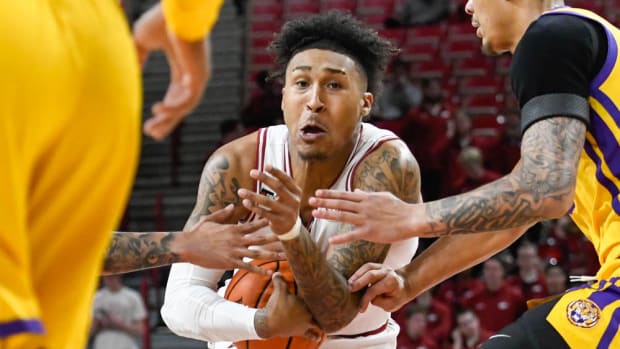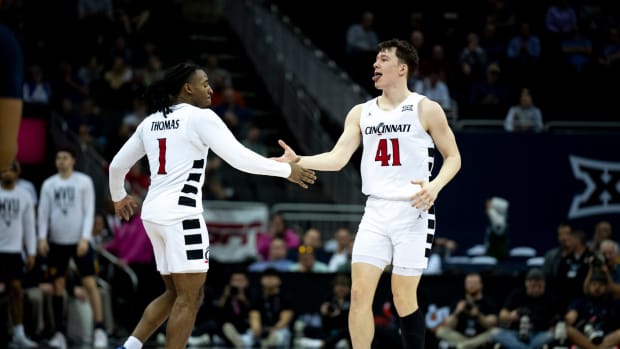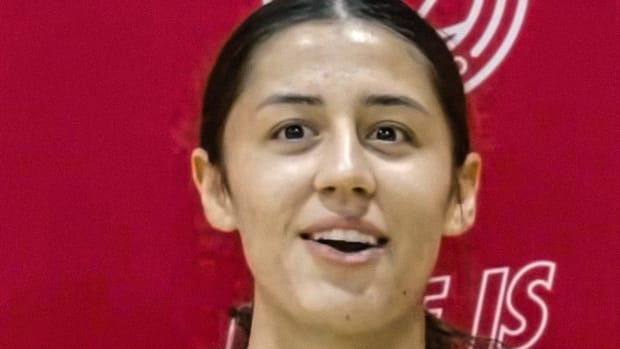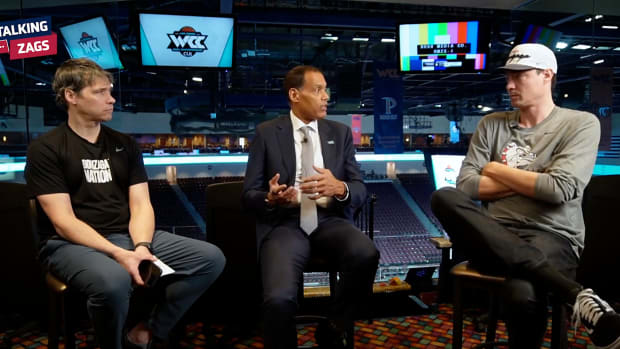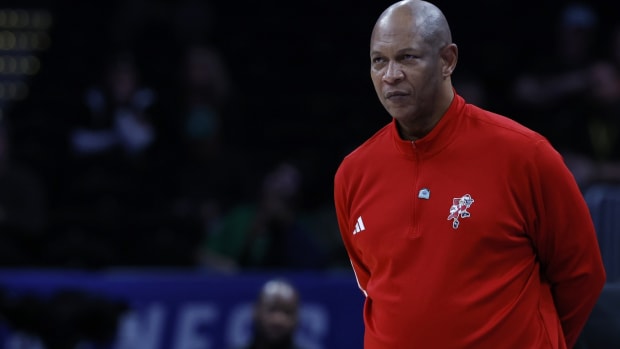What Do the Champions Classic Teams Need to Work On Going Forward?
Although this year’s Champions Classic by and large lived up to the hype, it’s crucial to remember what it is: the first game. Although one result does not a season make, Duke, Kentucky, Kansas and Michigan State—all top 10 teams and all contenders in their respective conferences—did offer quite a bit to think about going forward. Tuesday is in the rearview, and all four blue bloods will be major players the rest of the way. Based on what we saw in Indianapolis, all four have some things to iron out as non-conference play picks up.
Kentucky’s Lineup Shuffling
Losing by 30-plus to Duke on a neutral court with a throng of its own fans in attendance was not the way a highly-touted Kentucky team planned things. With the way the Blue Devils shot out of the gate, it was not altogether surprising to watch the moment get out of hand. While the Wildcats were the more experienced team in a literal sense, it seems ridiculous to posit that age should have been a factor in that matchup: Kentucky’s two best scorers (Keldon Johnson and Tyler Herro) and two point guards (Ashton Hagans and Immanuel Quickley) are all freshmen, their most experienced player (Reid Travis) is a transfer, and of their sophomores, only PJ Washington can reasonably be expected to swing a game. The sky isn’t falling.
The Wildcats play a tricky schedule as usual, but won’t face another high-major opponent for an entire month. They have time to work out the kinks and figure out lineup combinations. As has often been the case in recent years, Kentucky will look wildly different from November to January to March. It’s hard to pass a ton of judgment, as a result. Having options is nice, but expect John Calipari to eventually shorten the rotation a little bit as players separate themselves from the pack. Johnson, Herro, Washington and Travis are the most essential pieces of the team, but minutes may be otherwise fluid for this first leg of the season.
Although Duke is probably going to be the most difficult team to defend in the country, the loss did expose one structural weakness in Kentucky’s roster: a lack of depth on the wing. Johnson will bring consistent defensive effort, but Herro is a liability on that side of the ball, and those are Kentucky’s two legitimate options against opponents boasting size on the perimeter. Washington is a fairly agile 6’7” and Travis looks good switching and hedging ball screens, but both are going to be vulnerable if forced to defend in space. Maybe the Wildcats will be able to scheme better coverage (it wouldn’t be the worst idea to go zone in lineups where Washington is the nominal three), or maybe their guards will step up and allow them to play smaller. They have more than enough talent to beat most teams regardless, but how effectively Calipari goes about mixing and matching may determine where Kentucky’s ceiling lies.
WOO: Duke's Debut Resets the Expectations for Special Season
Kansas’s Perimeter Shooting
The gravitas of the Duke-Kentucky game was the night’s biggest story, overshadowing just how impressive Kansas looked for the majority of its win over Michigan State. Its frontcourt was incredibly productive, anchored by Dedric Lawson and the newly slim-thick Udoka Azubuike, and the game was swung by the fearless play of freshman guard duo Quentin Grimes and and Devon Dotson. Those four players are going to soak up big minutes and allow the Jayhawks’ role players to emerge. Bill Self was not shy about substituting, deploying 10 guys effectively against a Michigan State team that lacked the offensive talent to properly keep up. The game wouldn’t have been as close had they played a focused second half, and not left 13 free throws on the table.
Kansas’s balance is going to be too much for most opponents, but if there’s one thing to follow during the early part of the season, it’s how consistently it can keep shooting from outside. The Jayhawks made 10 of their 23 three-point attempts on Tuesday, but six of them came from a red-hot Grimes, and distance shooting was one of the few questionable parts of his skill set coming into the season. It’s possible he’s markedly improved, but he shouldn’t be counted on for consistent volume shooting just yet, and the same can be said of Dotson, who made 3 of 5 but seems to fling the ball at the rim a little bit. Lagerald Vick logged 32 minutes but had a brutal shooting night, missing all four threes. Sparkplug guard Charlie Moore logged just 11 minutes.
The Jayhawks’ patient offensive scheme paid dividends and fits their personnel nicely—there shouldn’t be undue pressure on any of their guards to penetrate, Lawson is an excellent passer and threat on dribble-handoffs, and Azubuike is a major load as a safety valve catching on the block. The bigs are good enough that Kansas will be able to play inside-out all season, but their perimeter players will have to consistently knock those clean looks down. We’ll need a bigger sample size to speak to where the freshmen are at as shooters, but if Tuesday sparks a trend, the Jayhawks are in great shape.
Michigan State’s Shot Creation
The Spartans are the only team that should have come away from the games with legitimate reason for concern, as it became clear that their talent level is a cut below relative to past seasons. To their credit, they never quit after falling behind by double-digits and got within striking distance of Kansas at the very end, spurred by the energy of Kenny Goins and Josh Langford. Their preseason ranking looks a bit lofty, but Michigan State has enough to contend in the Big Ten—even if it's going to need to overachieve to make that happen. Tom Izzo, of course, has been in these situations before.
Once again, the chief problem for Michigan State to address in non-conference play will be manufacturing halfcourt offense. This was an issue last season, even with future lottery picks Miles Bridges and Jaren Jackson Jr. on the floor. The Spartans just don’t have anyone they can throw the ball to to create a consistent look right now. Nick Ward predictably struggled against the Jayhawks’ length and rightfully ended up back in the doghouse down the stretch. That means a ton of their opportunities have to funnel through Cassius Winston, a good passer and system player who struggles to improvise in isolation. Winston piled up 11 assists against Kansas and made some nice plays, but a lot of those came in the flow of the attack. Langford had 18 points and may be their best hope to evolve into a crunch-time scorer. Goins hit a trio of threes and rebounds well, but needs shots created for him.
Looking at the pieces they have, barring a full Langford breakout, this may be an ongoing issue for the Spartans. Their defense and experience will keep them in a lot of games, but they are going to have to figure out ways to bridge the gap offensively against more talented, athletic teams that will try to kill their slow-footed bigs in transition. Their next big test comes with back-to-back games against UCLA and Louisville at the end of the month.
GEARY: FSU Already Showing Why Elite Eight Run Was No Fluke
Just kidding, there’s nothing bad to say about Duke yet
Writing responsibly about Duke requires some restraint right now. Their all-encompassing dominance against Kentucky rightfully makes them the early title favorite, as there’s not a single team in the country that can play them in transition, at least on paper. We can speculate as to how teams will try and stop the Blue Devils—Virginia and Syracuse will get two chances apiece to grind them to a halt in conference play—but until we see it happen, it’s fair to assume Zion Williamson, (whoa) R.J. Barrett (wow) and Cam Reddish (slightly lesser wow) will prove impossible for lesser teams to handle. Tre Jones will grow into his role, and Jack White looked versatile and tough enough against Kentucky to close games in March.
There are going to be distractions aplenty, and a race to prematurely crown what might become the most ballyhooed college team since the Fab Five, but from a pure on-court perspective, there simply isn’t anything to nitpick yet. Duke will face another lustrous spotlight at the Maui Invitational later this month, where it could end up playing fellow title contender Gonzaga. There will (probably) be some bumps in the road, as there are for most freshman-heavy college teams, but Duke simply didn’t look like most teams on Tuesday. For now, season to taste and enjoy the ride.

